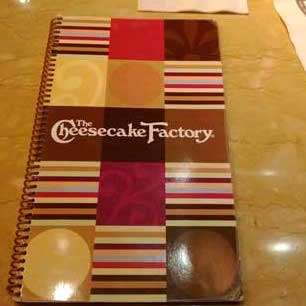Sitting down at a new restaurant often starts with browsing a menu of food items for you to order a la carte. The experience can be quite varied based on the number of items on the menu and how they’re presented.
There are those on the high end, fine dining restaurants, with a fancy menu that presents a short list of food items, exquisite descriptions, and no prices. And there are those in the fast casual category that have just a few menu items on a big board with a few choices, or those that have transformed via “Chipotle-ization” with all the food items presented as add-ons for you to point and choose, to build-as-you-go, for the ultimate in customized and personalized dining experience at a perceived-to-be-reasonable fast-casual price point.

Then, there are those casual dining experiences at big brand corporate restaurants like Cheesecake Factory or P. F. Chang’s, where the menu could be almost as thick as some college textbooks, and you’ve got hundreds of food items to order a la carte. (just noticed that Cheesecake Factory has over 250 dishes.) And, looking at the popularity of these restaurants, indicated by the usual minimum of an hour wait to get a table for your small group, lots of people are liking this kind of a dining experience.
So if people like to browse a giant menu of options in a sit-down restaurant, what if people could browse a church’s many ministry options like a restaurant menu?
And when I say browsing a list of ministries, I literally mean mindless browsing to see all the options, without having to type a keyword into a church ministries’ search engine, or clicking on categories or alphabetic letters. (Or, having to click 3-5 times to find information, yuk.)
Now, to be fair, the web-based version of the aforementioned big restaurant menus do have their dishes categorized, so I suppose that is one of the better practices for how to present a lot of information without overwhelming users. For a great example, Yard House does it right—one infinite scroll of food to eat; they don’t even call it a menu, it’s just “eat.”
Many churches (above the size of 100) have recognized the limitations of using a church bulletin to communicate all of its weekly activities and ministries. With about 50% of church goers attending churches sized 350 and above, there’s a huuuuge challenge for churches to communicate its many ministries and programs to its attendees and to its communities. With limited space being a premium, whether that’s in the church bulletin, the pre- and post- service slides, the social media timelines, or the church home page, churches are left with a strategy of highlighting just a few priority items to involve the largest majority.
Do you know of churches that are making information about their ministries widely available without usability frustrations? Is there a content management system built for this kind of a use case? Please add a comment to share.
What would happen to churches if the emphasis was no longer just on the weekend worship services or funneling people into small groups that meet in homes, but also making known the many available ministries that can help a lot more people if only more people knew about them?
Let’s make this a conversation starter for designing the future of the church. Instead of catching current trends, what if we created new trends, so that restaurants learn from churches about how to present many options? Here’s a pertinent excerpt from RestaurantEngine.com’s Trends in Restaurant Menu Design and Marketing:
While similar to the Millennials, Generation Z is the group of American teens beginning to make their own decisions about where they go to eat. To satisfy this crowd, restaurants should continue to market online menus. In turn, they’ll need to provide high-tech service, electronic menus and an exaggerated dining experience with unique and creative menu offerings that challenge diners.
